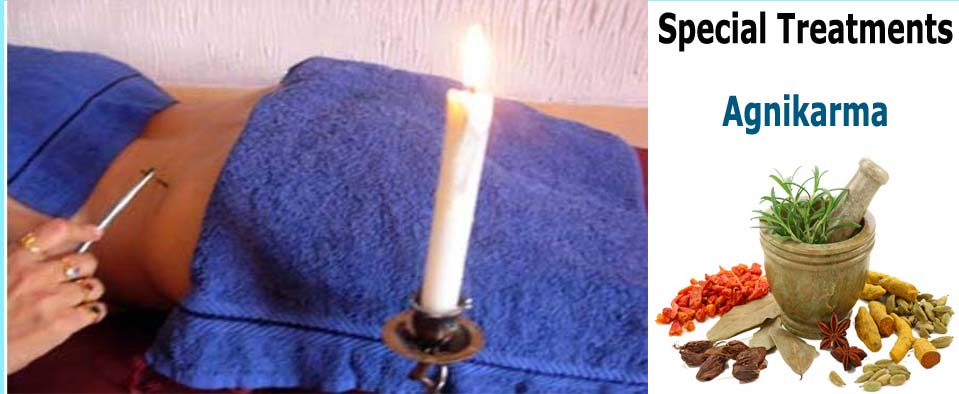

Rakta Mokshana – Blood letting
In whom Rakta Moshana is done
- Kushta - skin diseases 18 types
- Visarpa erisepalus
- Enlargement of spleen and liver
- Jaundice
- Ringworm, kandu
- Amla pitta – hyper acidity
- Excessive sleep
- Blood born diseases
- Pitta born diseases
- Headache
- Gout
- Agni mandya
- Tumours and glandular enlargement
- Alchoholism
- Drug addicted
- Suffering from poison
- Snake bite
- Allergies
- Also to healthy persons as preventive
What are the methods of Rakta Mokshana ?
Pracchana : Scraping by scapel usually done in superfacial blood letting.
Shringa : Horn of cow to withdraw superfacial blood after scraping, taking the advantage of its hollowness.
Alabu : A fruit of cucurbita lagnaria or vulgaris is dried and internal part is taken off, the hollow part is used for evacuation of blood by sucking method.
Jalooka : Leaches – blood sucking creaters are used.
Sira vedha : Taking blood from vein by syringe, Pracchana, Jalooka and siravedha is used in common practice.How to apply Jalooka -( LEACH )
Non poisonous leaches are kept in glass with water or in earthen pot for ready use.
Patients local part is washed and cleaned and dried.
Jalooka are first dripped in haridra jala (turmeric water) then ordinary water and placed by hand on the surface.
If not catching scrape a little and blood drop coming out will attract it to catch.
Usually 3 to 6 leaches may be applied one leach may succ 5 to 10 c.c. blood.
When they are full of blood, apply little salt water drop on their mouth, so that they leave the skin. Put them into salt water to vomit blood and into again clean water.
Dress the surface of patient by Jatyadi taila or padmakadintail.
Used jalooka can be used again after one month.How to do siravyadha
In olden days sira – Venous blood was taken out by direct cutting the vein which may not be practiced now, as it is dangerous and also not required as sophisticated needle and syringes are available.
Usually blood is taken from the vein in elbow joint as they are quite visible. May be taken at wrist and ankle joint also.
Put a light pressure on arm by hand or by B. P. instrument cuff or tornequet and sterlised syringe needle may insert in the vein when blood starts to come, take out piston and put a major glass below the other end of syringe to major it.How much blood can be taken out ?
100 to 250 ml. blood can be taken for elimination purpose at a time.
Can be repeated after 3 months.
Use of blood letting :
It is useful in pittaja and raktaja diseases.
The diseases which are not responding to other treatment in chronic stage – blood letting is useful in them
Chronic heart disease (Myocardial degeneration). Acute lobar pneumonia, uremia, acute pulmonary oedema, acute pericarditis are responded to blood letting.
It increases appetite, relieves ama dosha and long effect produces pure blood (Shuddha Rakta).
Useful in snake biteWhat are the Rasayanas to be given after Panchakarma
Select Rasayana according to disease
Following are some important Rasayana.
Rasayana churna Tridoshahar Satavari For Pitta Ashwagandha General tonic and good for tissues, mansa and shukra Kavacha paka for shukra Guduchi for Vata – Pitta, fever, T.B. and (Samshamani vati) chronic debility. Pippali For kapha and Dhatu paka Amalaki Rasayana General tonic Bramhi rasayana for brain tonic Haritaki Rasayana – All purpose Suvarna Malini vasant Circulatory problems and T.B. Makardhwaja for shukra and diabetes. Abhraka Bhasma T.B. and respiratory disorders also good for cardiac problem. Bala for vata diseases. Special Treatments
An account of the special and wonderful system of Ayurvedic Treatment peculiar to Kerala.
Even though there are guiding hints in our ancient and extensive medical lore, about the special courses of treatment, they are now prevalent only in kerala. It is also a fact that these hints were improved upon and brought up to their present state of perfection and effectiveness by the Ayurvedic system of treatments has made in-calculable progress. One of the reasons why the medical system of Kerala outshines all other systems of treatments, inclusive of the Ayurvedic system as prevalent elsewhere, in the treatment of paralysis, sciatica and such other forms of ‘Vatha’ and in the treatment of mental diseases like Hysteria, insanity etc., is the successful conducting of the special courses of treatments. The most important special courses as improved upon by the ancient Vaidyas of Kerala are Dhara, Pizhichil, Navarakizhi and Sirovasthi.




.jpg)



